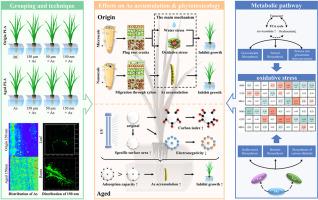老化和纳米聚乳酸增强水稻幼苗砷积累和植物毒性:与微尺度聚乳酸比较
IF 5.7
2区 生物学
Q1 PLANT SCIENCES
引用次数: 0
摘要
水稻在种植过程中受到砷和塑料的双重污染,引起了严重的食品安全问题。然而,微(纳米)塑料在砷积累中的作用及其潜在的毒性机制尚不清楚。因此,本研究采用荧光标记和激光剥蚀技术,观察聚乳酸(PLA)和砷在水稻幼苗中的原位分布,旨在阐明PLA对植物砷积累的载体影响。研究了不同龄期和不同粒径PLA对植物总砷积累的影响,并通过非靶向代谢组学方法研究了它们的联合污染对水稻幼苗代谢途径的影响,以阐明其潜在的毒性机制。结果表明,聚乳酸是一种有效的载体,通过木质部与砷共运,并在水稻幼苗叶脉中积累,从而增加了砷的总积累量。它们的联合污染以TCA循环和苯丙氨酸生物合成为关键代谢枢纽,从而影响与氧化胁迫抗性相关的下游代谢物,影响水稻幼苗的生长。本研究通过原位检测证实了聚乳酸和砷的共转运机制,有助于进一步了解微(纳)塑料增加植物体内重金属积累的机制及其健康风险。本文章由计算机程序翻译,如有差异,请以英文原文为准。

Aged and nano-sized polylactic acid enhanced arsenic accumulation and phytotoxicity in rice seedlings: Compared with micro-sized polylactic acid
Rice is significantly impacted by the combined pollution of arsenic and plastic during cultivation, raising serious food safety concerns. However, the role of micro(nano)plastics in arsenic accumulation and the underlying toxic mechanisms remains unclear. Therefore, this research employed fluorescent labeling and laser denudation techniques to observe the in-situ distribution of polylactic acid (PLA) and arsenic in rice seedlings, aiming to elucidate the carrier impact of PLA on plant arsenic accumulation. It examined the effects of varying aged and sized PLA on total arsenic accumulation in plants, and investigated the effects of their combined pollution on the metabolic pathways of rice seedlings by untargeted metabolomics to elucidate potential toxic mechanism. The results indicated that PLA was an effective carrier, which co-transported with arsenic through xylem and accumulated in the veins of rice seedlings, thereby increasing total arsenic accumulation. Their combined pollution targeted the TCA cycle and phenylalanine biosynthesis as critical metabolic hubs, thus influenced downstream metabolites associated with oxidative stress resistance and impacted the growth of rice seedlings. This study confirmed the co-transport mechanism of PLA and arsenic via in-situ detection, which will enhance understanding of the mechanisms on which micro(nano)plastics increase the accumulation of heavy metals in plants and their health risks.
求助全文
通过发布文献求助,成功后即可免费获取论文全文。
去求助
来源期刊
CiteScore
11.10
自引率
3.10%
发文量
410
审稿时长
33 days
期刊介绍:
Plant Physiology and Biochemistry publishes original theoretical, experimental and technical contributions in the various fields of plant physiology (biochemistry, physiology, structure, genetics, plant-microbe interactions, etc.) at diverse levels of integration (molecular, subcellular, cellular, organ, whole plant, environmental). Opinions expressed in the journal are the sole responsibility of the authors and publication does not imply the editors'' agreement.
Manuscripts describing molecular-genetic and/or gene expression data that are not integrated with biochemical analysis and/or actual measurements of plant physiological processes are not suitable for PPB. Also "Omics" studies (transcriptomics, proteomics, metabolomics, etc.) reporting descriptive analysis without an element of functional validation assays, will not be considered. Similarly, applied agronomic or phytochemical studies that generate no new, fundamental insights in plant physiological and/or biochemical processes are not suitable for publication in PPB.
Plant Physiology and Biochemistry publishes several types of articles: Reviews, Papers and Short Papers. Articles for Reviews are either invited by the editor or proposed by the authors for the editor''s prior agreement. Reviews should not exceed 40 typewritten pages and Short Papers no more than approximately 8 typewritten pages. The fundamental character of Plant Physiology and Biochemistry remains that of a journal for original results.

 求助内容:
求助内容: 应助结果提醒方式:
应助结果提醒方式:


